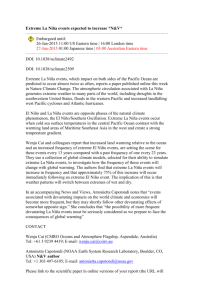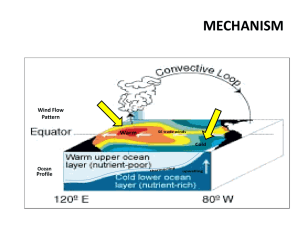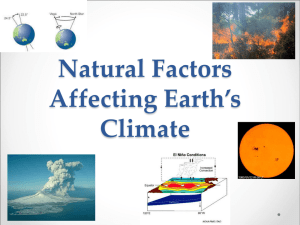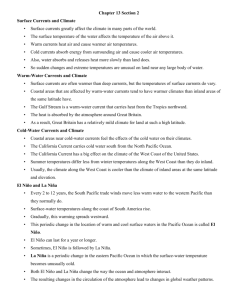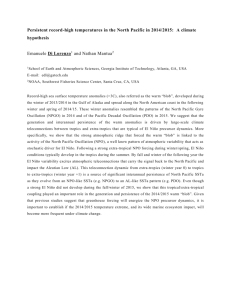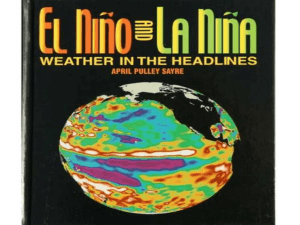grl53295-sup-0001-supplementary
advertisement
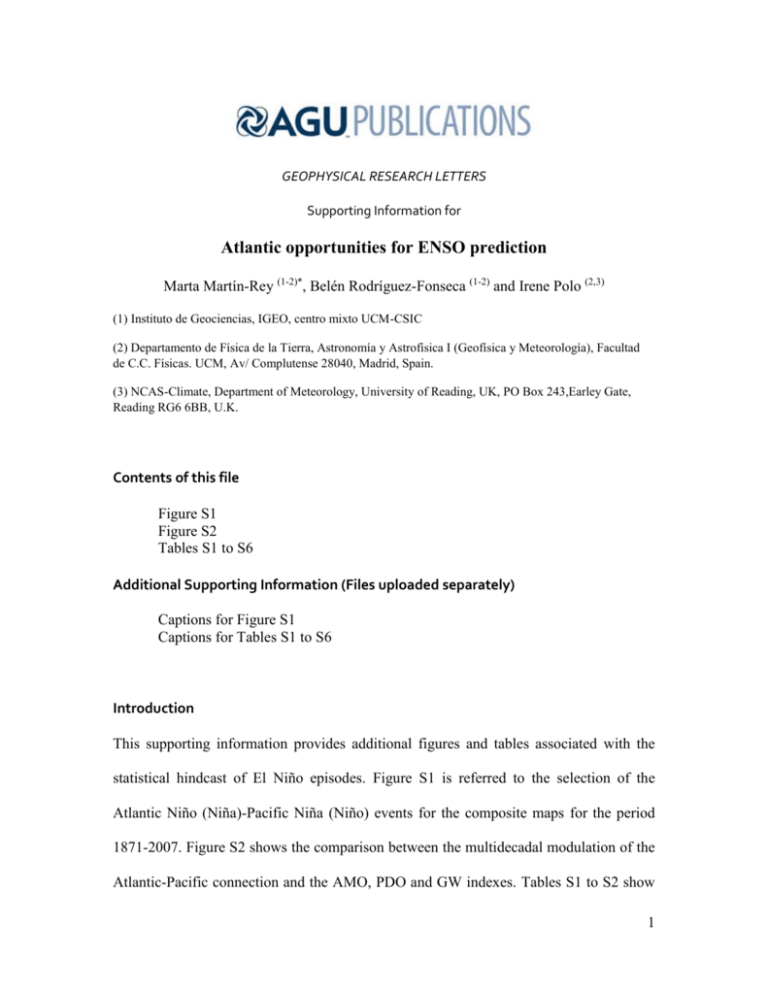
GEOPHYSICAL RESEARCH LETTERS Supporting Information for Atlantic opportunities for ENSO prediction Marta Martín-Rey (1-2)*, Belén Rodríguez-Fonseca (1-2) and Irene Polo (2,3) (1) Instituto de Geociencias, IGEO, centro mixto UCM-CSIC (2) Departamento de Física de la Tierra, Astronomía y Astrofísica I (Geofísica y Meteorología), Facultad de C.C. Físicas. UCM, Av/ Complutense 28040, Madrid, Spain. (3) NCAS-Climate, Department of Meteorology, University of Reading, UK, PO Box 243,Earley Gate, Reading RG6 6BB, U.K. Contents of this file Figure S1 Figure S2 Tables S1 to S6 Additional Supporting Information (Files uploaded separately) Captions for Figure S1 Captions for Tables S1 to S6 Introduction This supporting information provides additional figures and tables associated with the statistical hindcast of El Niño episodes. Figure S1 is referred to the selection of the Atlantic Niño (Niña)-Pacific Niña (Niño) events for the composite maps for the period 1871-2007. Figure S2 shows the comparison between the multidecadal modulation of the Atlantic-Pacific connection and the AMO, PDO and GW indexes. Tables S1 to S2 show 1 the observed Atlantic Niño and Niña events and the observed and simulated ENSO episodes. Tables S3 to S6 indicate the variance, correlation scores and root mean square errors between the observed and predicted tropical Pacific variables related to the Atlantic-forced El Niño episodes for each of the three periods of study: 1871-1938, 19391966 and 1967-2007. 2 Figure S1. Selection of the Atlantic Niño -Pacific Niña (Niño) events. (a) Expansion coefficient of summer tropical Atlantic SSTs for values higher than 1 std (red bars) as indicator of Atlantic Niños and winter Niño3 index for observations (light blue bars) and hindcast (dark blue stems) for the period 1871-2007. (b) Expansion coefficient of summer tropical Atlantic SSTs for values lower than -1 std (light blue bars) as indicator 3 of Atlantic Niñas and winter Niño3 index for observations (dark pink bars) and hindcast (purple stems) for the period 1871-2007. The dark lines separate the three different periods of study: 1871-1938, 1939-1966 and 1967-2007. The expansion coefficient of tropical Atlantic SSTs comes from the EMMCA for the period 1871-2007. The observed Niño3 index has been computed from HadISST (Rayner et al. 2003). 4 Atlantic Niñas Niño3 obs Nino3 mod Atlantic Niñas Niño3 obs Nino3 mod 1874 Neutro Niña 1948 Niño Niña 1880 Niño Niño 1950 Niña Niña 1882 Niño Niño 1954 Niña Niño 1887 Niño Niño 1958 Niño Niño 1890 Niño Niño 1961 Niña Niña 1894 Niña Niño 1964 Niña Niño 1898 Niña Niño 1967 Niña Niña 1902 Niño Niño 1974 Niña Niña 1911 Niño Niña 1976 Niño Niña 1914 Niño Niño 1982 Niño Niño 1918 Niño Niña 1985 Niña Niña 1922 Niña Niña 1989 Niño Niño 1932 Niña Niño 1990 Niño Niña 1935 Niña Niño 1992 Niño Niña 1940 Niño Niño 1994 Niño Niño 1943 Niña Niña 1997 Niño Niño 1945 Niña Niño 2000 Niña Niño Table S1. Observed Atlantic Niña events from the expansion coefficient from the EMMCA for the period 1871-2007. The observed and predicted Niños are also shown, from the Niño3 index. The selected events for the composite are shown in blue. 5 Atlantic Niños Niño3 obs Nino3 mod Atlantic Niños Niño3 obs Nino3 mod 1875 Niño Niña 1947 Niño Niño 1877 Niño Niño 1949 Niña Niño 1881 Niño Niño 1951 Niño Niña 1886 Niña Niño 1959 Niña Niña 1889 Niña Niña 1963 Niño Niño 1893 Niña Niña 1966 Niña Niño 1897 Niña Niño 1968 Niño Niño 1899 Niño Niño 1973 Niña Niña 1909 Niña Niña 1977 Niño Niña 1912 Niña Niña 1979 Niño Niño 1915 Niño Niña 1983 Niña Niña 1919 Niña Niña 1984 Niña Niña 1921 Niña Niña 1987 Niño Niña 1924 Niña Niña 1993 Niño Niña 1931 Niña Niño 1995 Niña Niña 1933 Niña Niña 1998 Niña Niña 1934 Niña Niña 2003 Niño Niño 1937 Niña Niño 2008 Niño Niña 1944 Niña Niño Table S2. Observed Atlantic Niño events from the expansion coefficient from the EMMCA for the period 18712007. The observed and predicted Niños are also shown, from the Niño3 index. The events selected for the 6 composite are shown in red. VARIANCE 1871-1938 1939-1966 1967-2007 OBS PRED OBS PRED OBS PRED SSTE 0.75 3.91 0.55 0.75 0.72 3.62 USTR 0.06 0.01 0.06 0.01 0.07 0.03 Z20J 4.07 0.28 4.50 21.13 8.46 18.94 Z20D 6.72 20.46 5.73 6.84 8.67 38.40 Table S3. Variance of the observed and predicted Pacific variables associated with the Atlantic-forced El Niño episode: zonal wind in JASO in the western Pacific [120E-180, 15N15S], z20 in JASO and DJFM over central Pacific [180°-130°W; 5°N-5°S] and SST in DJFM over the central-eastern equatorial Pacific [180°-80°W, 5°N-5°S] for the periods 1871-1938, 1939-1966 and 1967-2007. 7 CORRELATION 1871-1938 1939-1966 1967-2007 SSTE .57* .09 .64* USTR .21* .16 .50* Z20J .01 .39* .28* Z20D .33* .14 .56* Table S4. Correlation scores between the observed and predicted Pacific variables associated with the Atlantic-forced El Niño episode: zonal wind in JASO over western Pacific [120E-180, 15N15S], z20 in JASO, and DJFM over central Pacific [180°-130°W; 5°N-5°S] and SST in DJFM in the central-eastern equatorial Pacific [180°-80°W, 5°N-5°S] for the periods 1871-1938, 1939-1966 and 1967-2007. The stars (*) indicate the statistically significant correlation values according to a T-test considering the 90% confidence level. 8 RMSE 1871-1938 1939-1966 1967-2007 SSTE 3.50 .87 3.17 USTR .01 .01 .02 Z20J 4.04 19.58 18.19 Z20D 19.15 8.18 33.88 Table S5. Root mean square error between the observed and predicted Pacific variables associated with the Atlantic-forced El Niño episode: zonal wind in JASO over western Pacific [120E-180, 15N15S], z20 in JASO, and DJFM over central Pacific [180°-130°W; 5°N-5°S] and SST in DJFM in the central-eastern equatorial Pacific [180°-80°W, 5°N-5°S] for the periods 1871-1938, 1939-1966 and 1967-2007. 9 RMSE/STD 1871-1938 1939-1966 1967-2007 SSTE .90 1.17 .87 USTR 1.02 1.06 .89 Z20J 14.67 .93 .96 Z20D .94 1.20 .88 Table S6. Root mean square error relative to the standard deviation of each of the the observed and predicted Pacific variables associated with the Atlantic-forced El Niño episode: zonal wind in JASO over western Pacific [120E-180, 15N15S], z20 in JASO, and DJFM over central Pacific [180°-130°W; 5°N-5°S] and SST in DJFM in the central-eastern equatorial Pacific [180°-80°W, 5°N-5°S] for the periods 18711938, 1939-1966 and 1967-2007. References Compo, G. P., et al. (2011), The Twentieth Century Reanalysis Project, Q. J. R. Meteorol. Soc. 137,1–28. Martín-Rey, M., B. Rodríguez-Fonseca, I. Polo and F. Kucharski (2014), On the AtlanticPacific Niños connection: A multidecadal modulated mode, Clim. Dyn., doi: 10.1007/s00382-014-2305-3. Rayner, N. A., D. E. Parker, E. B. Horton, C. K. Folland, L. V. Alexander, D. P. Rowell, E. C. Kent, A. Kaplan (2003), Globally complete analyses of sea surface temperature, sea ice and night marine air temperature, 1871-2000, J. Geophys. Res., 108, 4407. 10
